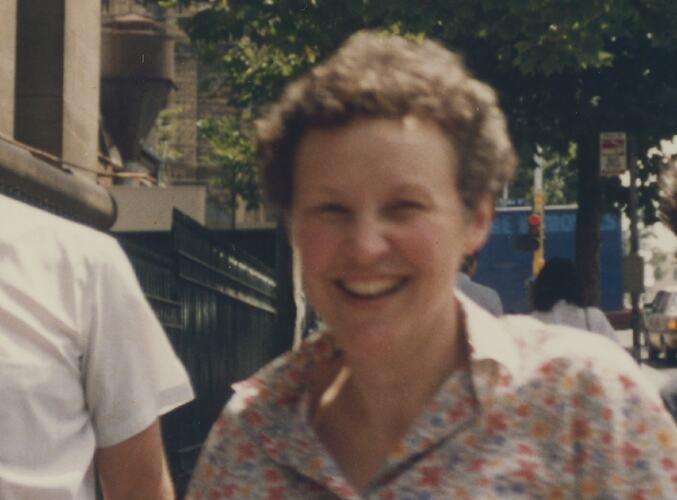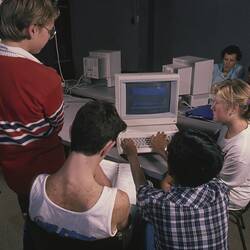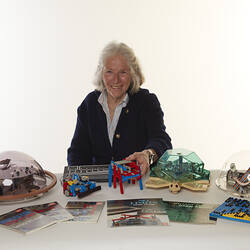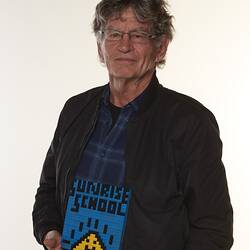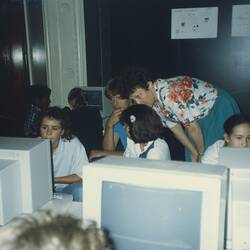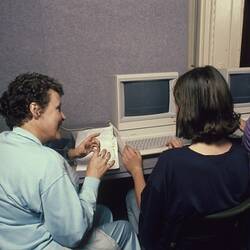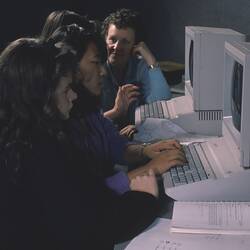Margaret Fallshaw was a teacher and computing consultant who played an important role in the development of educational computing in Victoria and Australia. Notably, she was involved with the Australian Council for Educational Research (ACER) Sunrise School educational technology project in the late 1980s, and the transformation of Methodist Ladies College (MLC) into the world's first 'laptop school' in the early 1990s.
Margaret Craig Fallshaw (nee Wilson) was born on 1 June 1946 in East Gippsland. Her family ran a small sheep farm at Doctors Flat and grew and made most of their food (milking the cow, churning the butter, picking the vegetables, slaughtering their own meat, making scones to feed the shearers). Life moved at a slow pace in these times. Indeed, it was not until 1976 that electricity was connected to the district.
Margaret attended the local Swifts Creek Higher Elementary School (P-10). She became a voracious reader, consuming every book from cover to cover, including the dictionary! She fondly remembered travelling to Bairnsdale with her parents two or three times a year to buy flour, salt, sugar and other necessities and, importantly, to visit the library to exchange her cherished books.
Margaret went to secondary school in Melbourne as a boarder at Presbyterian Ladies College. While she loved school, and had a talent for maths and science, she missed her family deeply. Her family made the decision to leave the farm and move to the city to support her education and that of her two sisters. This was a significant change to family life: her father took on factory work and her mum returned to nursing. After graduating from Presbyterian Ladies College, Margaret went on to complete a Bachelor of Science and a Diploma in Education at Monash University. In later years, she completed a Bachelor of Education.
While studying at Monash University, Margaret met Robert Fallshaw, an engineer and manufacturer. They met through what is likely to have been one of the world's first 'computer dating' services! The data science and psychology students at Monash University and Melbourne University (where Rob was studying) had developed a computer program that matched students seeking romance based on information they provided in a questionnaire. The program matched Rob with three students. Margaret was his third date. He took her skiing. She fell over constantly but always got back up. They fell in love and married three months later. Although having never previously left the country, they honeymooned in Russia, Iran, Siberia, and India! Two years later they had the first of their four children.
Despite being a busy stay-at-home-mum, Margaret made the time to engage in various campaigns to make the world a better place. She was instrumental in the protest movement to remove lead from petrol and paint; always wearing a twin set and pearls to the protests and carrying a child on her hip so she would stand out from the crowd and attract the attention of reporters. Margaret was also extremely active in the Nursing Mothers Association, teaching new mothers to breastfeed and promoting the health benefits of breast feeding.
Margaret maintained her keen interest in education, reading widely and keeping abreast of a range of developments in the field. She was particularly interested in evidence-based approaches to learning and the use of educational technologies. Two educationalists that had a significant impact on her approach to learning and teaching were Howard Gardner (who developed the theory of multiple intelligences) and Seymour Papert (whose learning theory constructionism and approach to using computers in education directly underpinned the work of the Sunrise School and developments at MLC).
Margaret applied her educational knowledge and skills to many aspects of her life. She designed and ran training sessions and contributed to key production changes (including the introduction of robotics) at the family manufacturing business managed by her husband. She was also Education Convenor for the State Liberal Party and was instrumental in writing the ambitious education policy of the ill-fated 'Fight Back' campaign of John Hewson.
When her youngest child was of primary school age, Margaret returned to classroom teaching at Princes Hill Secondary College. In 1988, the school agreed to participate in the ACER Sunrise School - an applied research project designed to explore how computers might be best used to enhance learning. Margaret was one of three teachers from Princes Hill Secondary College involved in the project. Two afternoons each week through 1988 and 1989, Margaret took one of her classes to the Sunrise School, a dedicated technology-rich area located inside the Museum of Victoria. Here she engaged her students in a range of self-directed learning activities using the school's computers, robotics equipment and other digital technologies. Magaret absolutely loved it! The project combined her passion for education and technology, and she thrived.
Margaret left Princes Hill Secondary College and joined MLC as Computer Coordinator at the conclusion of the Sunrise School project. MLC had been inspired by the Sunrise School to rethink and expand its use of computers and, with assistance from ACER, established its own Sunrise Centre in 1989. As Computer Coordinator, Margaret was instrumental in the transformation of MLC into the world's first 'laptop school' - a school where students had their own personal laptops that they used in classes across the curriculum. In addition to training teachers and students in how to use computers, Margaret played a key role in establishing and maintaining the school's new and expanding computer infrastructure. This was pioneering work! She negotiated supply contracts with Toshiba, Compaq and other IT providers, and found ways to deal with the practicalities of keeping hundreds of laptops charged and bug-free all day.
Margaret passed away after battling breast cancer on 28 October 1995.
More Information
-
Keywords
-
Authors
-
Contributors
-
Article types
